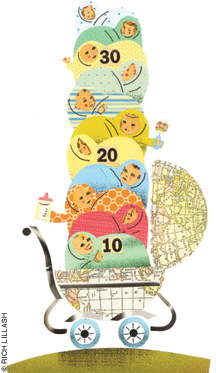
Bending the Population Fertility Curve
As countries climb the ladder of economic development, their fertility rates decline. This longstanding relationship figures into all sorts of social phenomena, from the participation of women in the workforce to the strain an aging population can exert on government social-insurance programs. But a new finding by Mikko Myrskylä and Hans-Peter Kohler of Penn’s Population Studies Center, and Francesco C. Billari of the Università Bocconi in Italy, puts a twist on that conventional wisdom.
In the August 6 issue of Nature, the researchers reported that when countries achieve a sufficiently high level of development, their fertility rates actually begin edging up again—although not quite to the population-replacement level.
Examining 24 countries over a 30-year period, they found that the well-established negative relationship between development and fertility has shown signs of reversal in the early 21st century.
“This study provides some light at the end of the tunnel for countries that were concerned about population aging and population decline as a result of very low fertility rates,” says Kohler, a professor of sociology. “[It] will almost certainly generate additional research to better understand the underlying mechanisms of fertility change and possible policy responses to low fertility.”
Social Moms Make Better Moms—in Baboons
If you were a baby baboon hoping to have some babies of your own someday, nothing would improve your chances like having a social butterfly as your own mother. That’s according to an analysis of 17 years of research on 66 adult female baboons in Botswana’s Moremi Game Reserve by biology professor Dorothy Cheney [“Who’s Who on the Savannah,” May|June 2004] along with researchers from UCLA, the University of Michigan, and the University of St. Andrews. The scientists found that the strength of a female’s social bonds with other females was the best predictor of whether her children would live to bear offspring of their own.
Although the mechanism is unclear, the study suggests that maternal sociability may somehow buffer stress experienced by their offspring. Stress hormones like cortisol can lead to health problems in baboons (as well as humans), and research has also shown that grooming can lower stress hormones in baboons.
“Females who raise offspring to a reproductive age are more likely to see their genes pass along, so these findings demonstrate an evolutionary advantage to strong relationships with other females,” says Cheney. “In evolutionary terms, social moms are the fittest moms—at least when it comes to baboons.”
Houses of Blues
Nothing is more central to the American dream than owning your own home, and few things are touted to have so many benefits. Homeownership is commonly credited with everything from forging personal fulfillment to bolstering civic engagement. But recent research by Grace Wong Bucchianeri, assistant professor of real estate at Wharton, calls that received wisdom into question.
In a working paper drawing on data from a respected well-being survey of 600 women in Ohio, she argues that homeownership doesn’t make people happier than writing rent checks, doesn’t increase civic participation, and may even be a source of psychological anguish. Bucchianeri also found that—among this somewhat limited sample—homeowners tend to be about 12 pounds heavier than comparable renters.
Overall, Bucchianeri says, homeowners tend to be a contented bunch. “But if you control for very basic variables that we suspect would be related to happiness and housing—such as income, education, age—that well-being gap goes away.” Meanwhile, what might be called a misery gap takes its place. Homeowners “report a significantly higher amount of pain derived from their home and neighborhood.”
The last couple years, of course, have been tough ones for mortgagers. But Bucchianeri collected her data during 2005. “If there was a time that people should have felt happy about homeownership,” she says, that was it.

